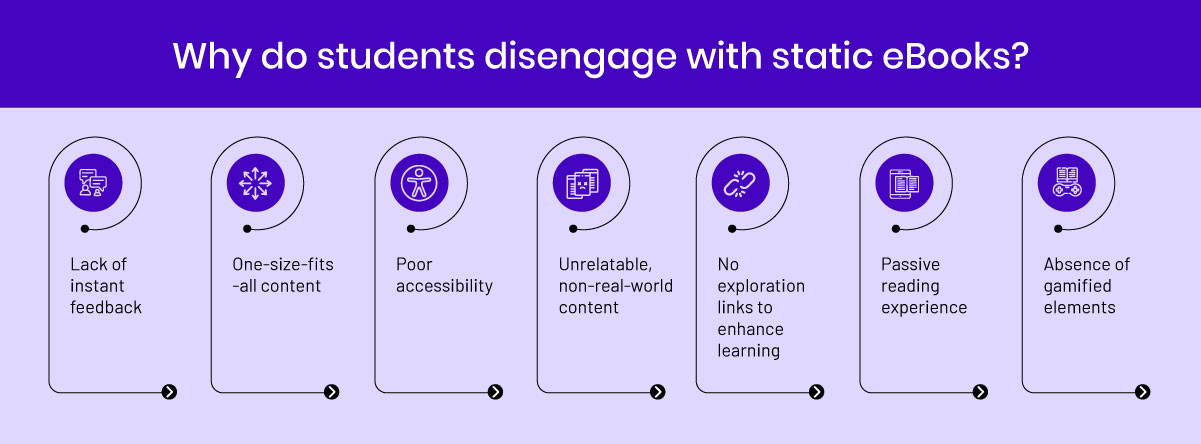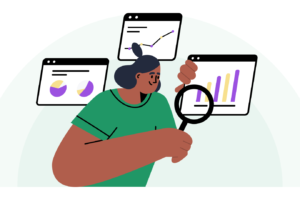
Can Interactive eBook Publishing Close the Engagement Gap in Classrooms
Do you know why engaging students in the learning process is critical? Student engagement is directly correlated with learning attainment. This, by extension, affirms what studies have been proving for some time now – disengagement of learners translates into learning gaps, which affect academic achievement. A Gallup study found that between 25% and 54% Gen-Z students are not well-engaged in their school experiences. With Gen-Alpha entering the classrooms, the disengagement problem is expected to become even more prominent. In an increasingly digitalized learning ecosystem, static PDFs are possibly the least engaging type of learning material. And the K-12 group certainly needs more than just digital replicas of print materials. They need eBooks to interact with, to broaden the horizon of their imagination, enable them to relate their learning to the real world, and, most importantly, motivate them to learn. This necessitates publishing interactive eBooks while simultaneously creating an opportunity for publishers to elevate learner achievement.
What Makes eBooks Truly Interactive?
Consider a student who reads text, observes some images, highlights key points, and moves on to the next chapter. Nothing wrong with it. But do you find anything exciting about it?


Think of the experience of a student using an eBook enriched with engaging features. Maybe an embedded multimedia showing how gears actually push each other forward. Or, just a text-to-speech converter, for when reading feels boring, the student is in the mood for an ebook narration. Features that engage multiple senses and offer the flexibility to continue learning in a format preferred by students in the moment have the power to deepen understanding and maintain curiosity, thus boosting engagement.
A student engagement-focused eBook includes a variety of interactive elements, such as multimedia, self-check quizzes, audio narration, hotlinks, etc. These invite students to be active participants in the learning process rather than passive consumers. Tools for annotations, bookmarking, and note-taking personalize learning experiences to a large extent. Hotlinks to supplementary resources allow learners to explore beyond the curriculum, dive deeper into areas of interest, and review past concepts for reinforcement.
eBooks for student engagement create dynamic environments where learning flows through interactive journeys with intuitive navigation and responsive design, while also ensuring accessibility across devices.
How Interactive eBooks Help Educators Win
Did you know that publishing interactive eBooks creates more opportunities to gather learning metrics? With more touchpoints for learners, educators get more data points for effective learning analytics. Tracking K-12 digital content use across the digital learning platform creates opportunities to deliver more extensively personalized experiences. Teachers benefit from interactive eBooks as real-time analytics and trackable insights paint a clear picture of student progress. This enables them to ensure timely intervention and prevent learning gaps from forming. This, in turn, lowers the chances of disengagement.
Assignable modules and quizzes allow teachers to create tailored learning journeys, while simultaneously accommodating individual needs of being challenged, supported, motivated, or just pushed a little bit. Better yet, AI-powered automation can handle module assignment, while teachers can focus on targeted student support and classroom management.
The digital education publishing space, especially K-12, can integrate feedback loops to make interactive eBooks even more engaging and goal-oriented. Gamified pop quizzes and students’ responses enable continued monitoring of learners’ progress. These support a more responsive digital instruction model. More meaningful engagement paves the way for higher academic achievement.
A Strategic Shift for Publishers
Interactive eBook publishing is not just a product but also a strategic shift for publishers. It changes the way you manage K-12 digital content and deliver educational experiences that resonate with learners. Here’s how to make it better as a K-12 publisher:
- Issue anytime, anywhere updates across digital learning platforms.
- Trusting a DRM system is crucial to protecting your content. It uses time and role-bound access to control accessibility while preventing content reproduction.
- Leverage mobile-first edtech solutions for publishers to effortlessly scale across devices.
- Employ AI-powered analytics to support personalized learning experiences.
- Embed accessibility and equity within eBooks with multilingual support, text-to-speech conversions, captioning, and offline accessibility.
Publishing and distributing your interactive ebooks across digital learning platforms with API-powered integrations works as a market differentiator. Deeply engaging learning experiences are what today’s schools are looking for.
Engagement that Fuels Achievement
K-12 publishers can drive real classroom impact by innovating how educational content is delivered. Publishing interactive eBooks that offer immersive, multi-sensory, personalized, and equitable learning experiences prevents you from drowning in the sea of competition. As you invite exploration and student participation, your upgrade to cutting-edge edtech solutions for interactive publishing turns into meaningful ROI with increased adoption, driven by better experiences and academic achievement.
Explore MagicBox’s Learning Product Advisory Services to offer top-of-the-line technology and craft effective strategies as you roll out learning resources that spark curiosity via interactive eBook publishing.
Source link




